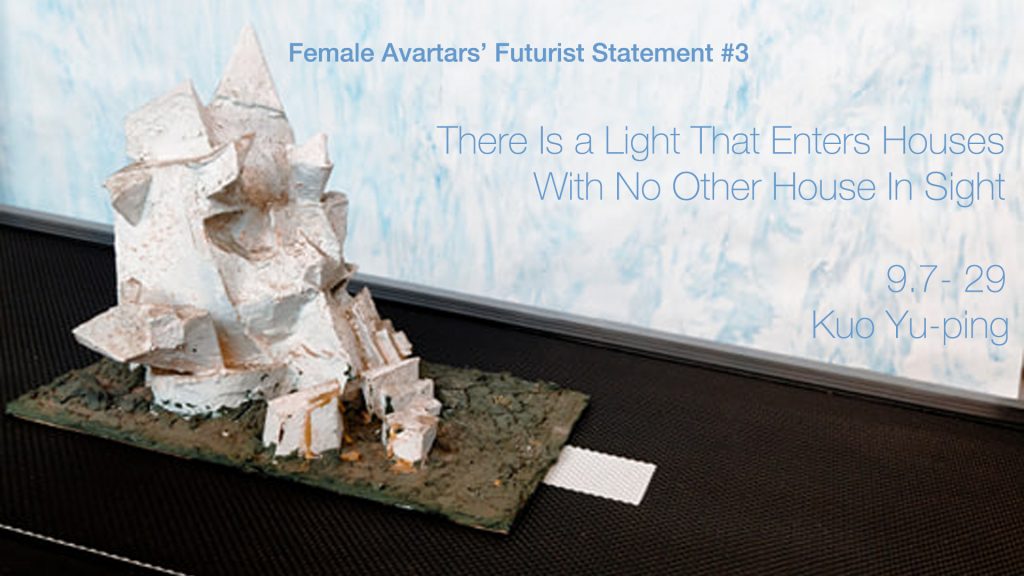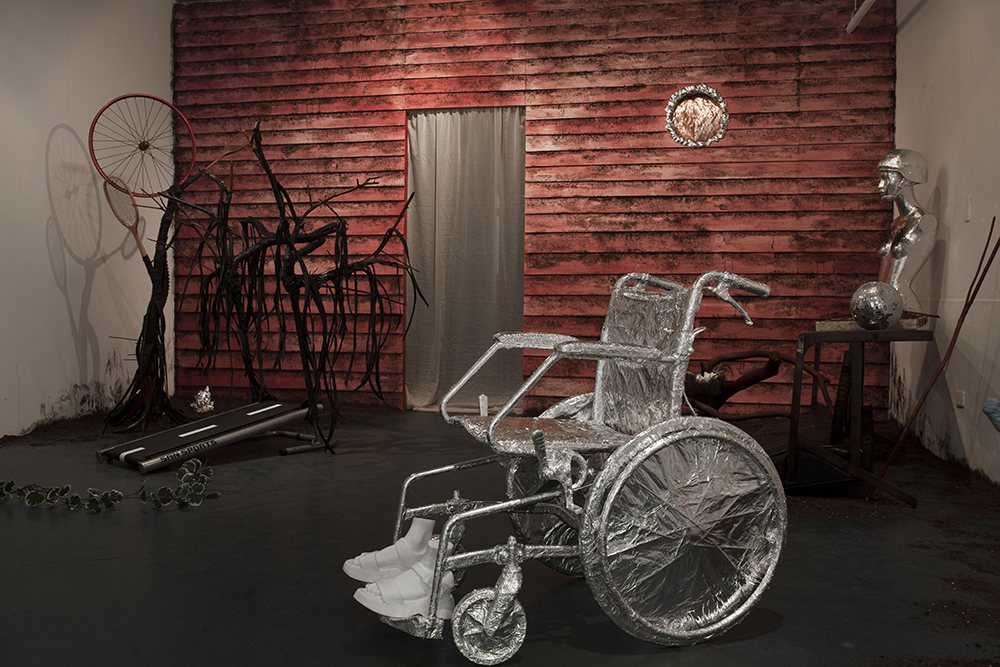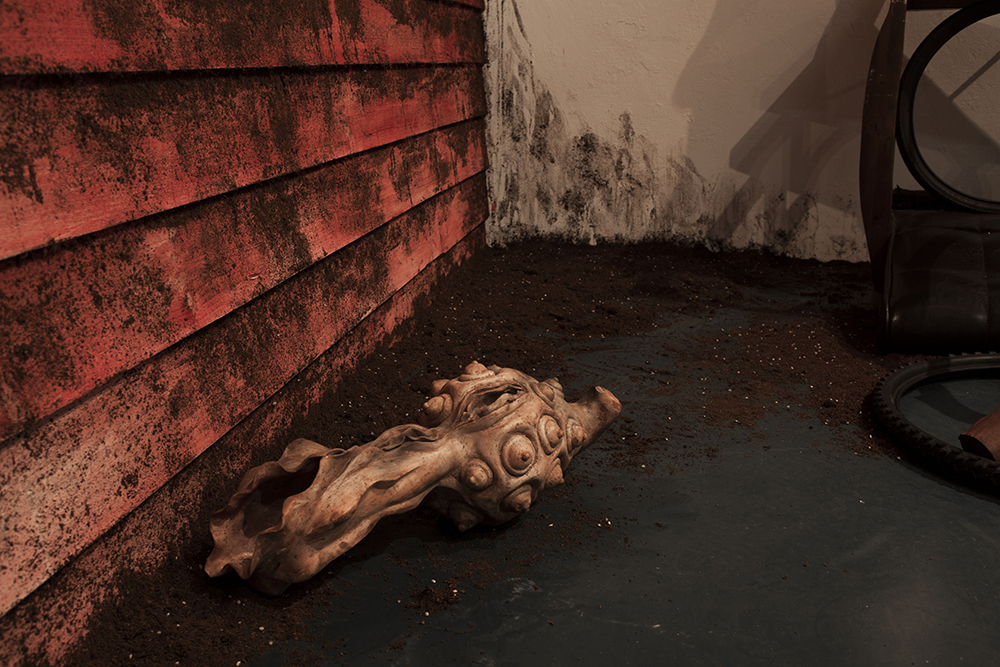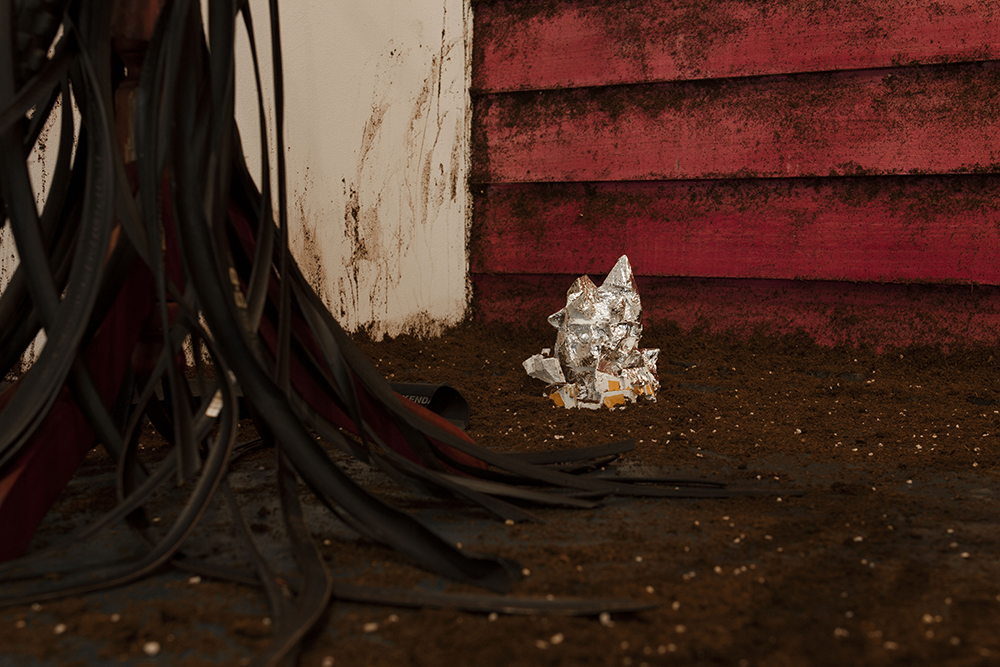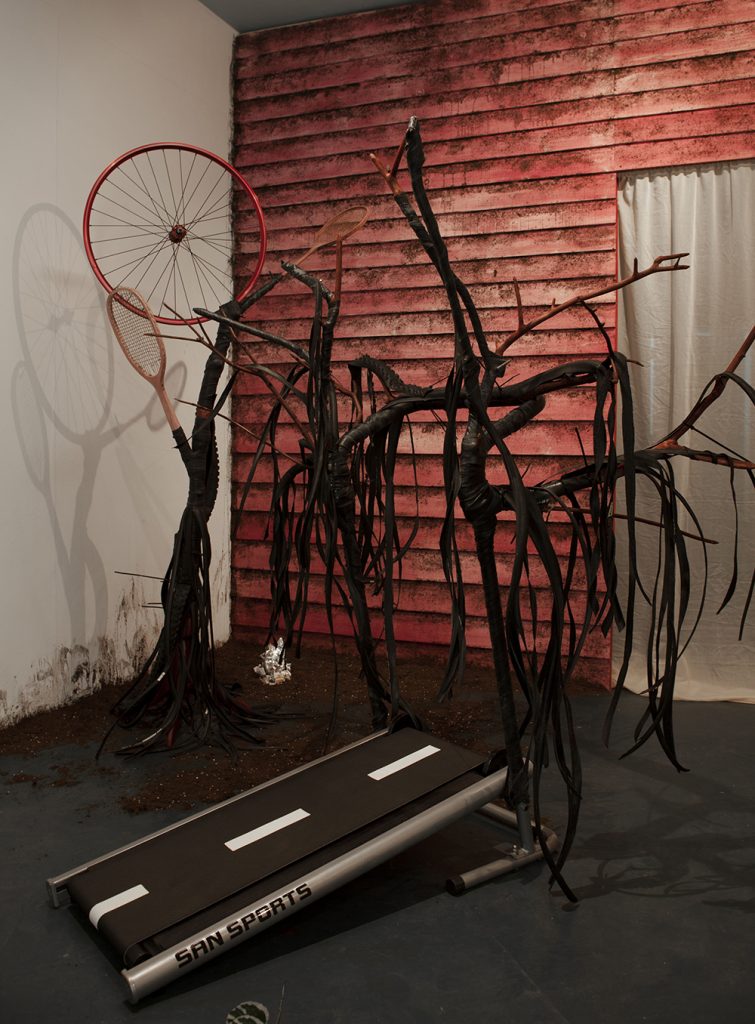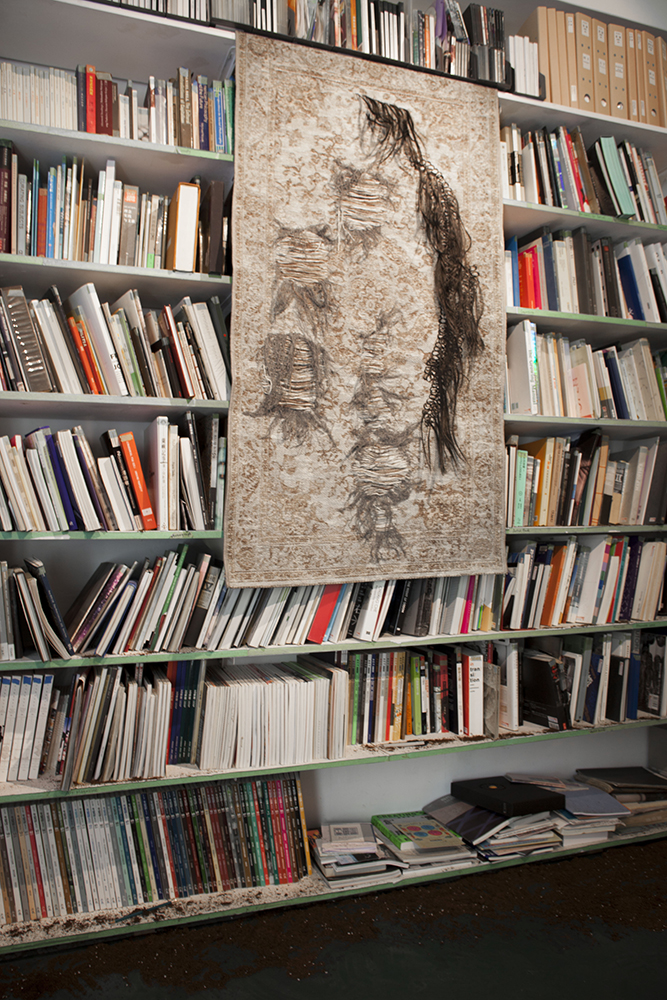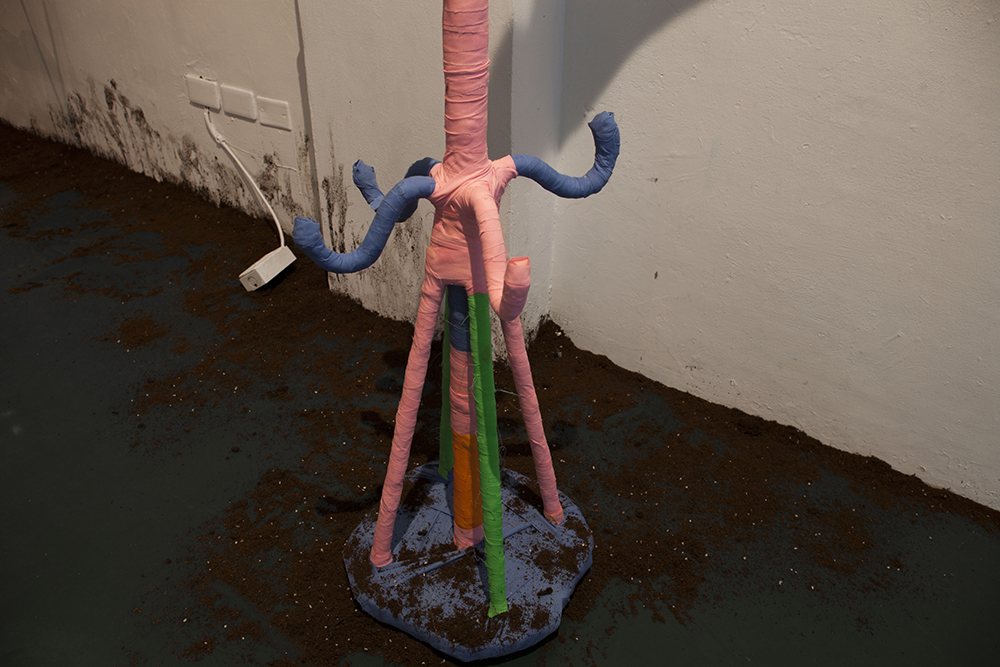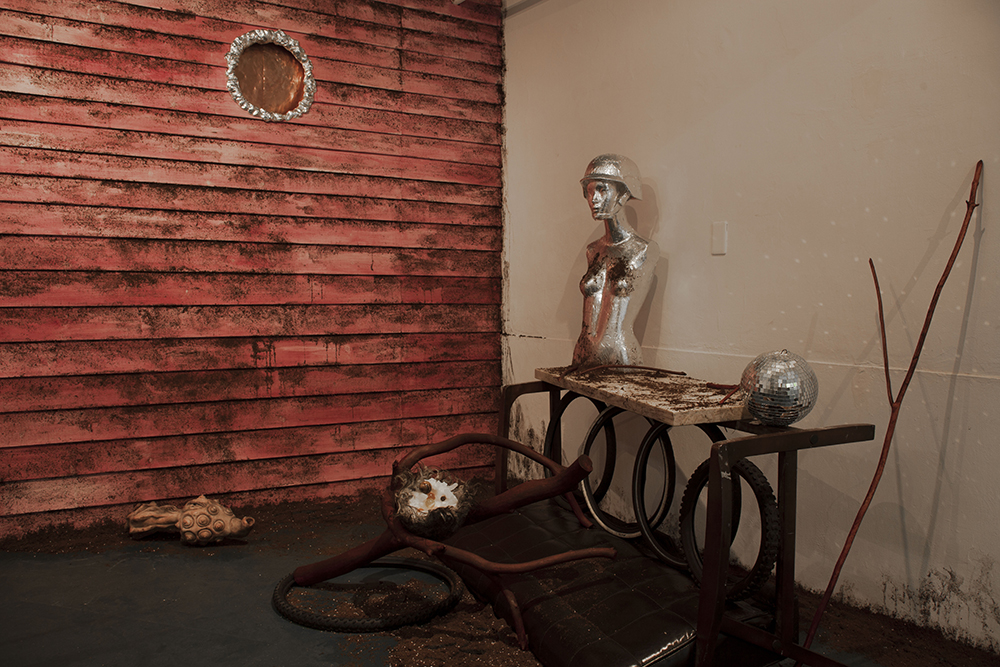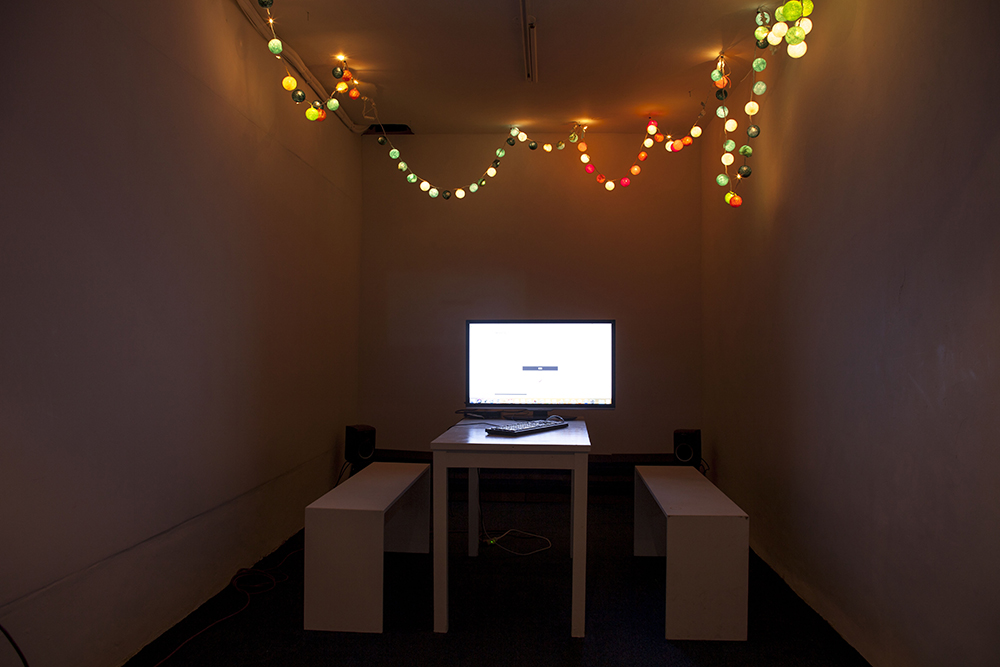(For English, Please Scroll Down)
⤞女頭目的未來學 #3⤝
郭俞平 –〈一盞燈進入房子,看不到其他房子〉
時間:2019.09.07 – 09.29,每週二到日,1-7pm
地點:台北當代藝術中心 TCAC (台北市大同區保安街49巷11號1樓,近捷運大橋頭站)
開幕:2019.09.07 6pm
台北當代藝術中心(TCAC)推出2019全新帶狀節目《女頭目的未來學》,第三回合為台灣藝術家郭俞平呈現現地製作裝置〈一盞燈進入房子,看不到其他房子〉。展覽橫跨 TCAC 一樓與地下室展間,呈現一個幽暗詭譎的居所。本件裝置同時包含一個參與式寫作計畫,邀請觀眾以文字搭建自己心目中的房屋,試圖建構與拓展包容各種私人敘事的公共空間。
〈一盞燈進入房子,看不到其他房子〉延續郭俞平以「洞」作為主體精神與外部空間連結,近一步以房屋作為主體意識的具象化符號進行創作。本展覽邀請觀眾自由探索一樓與地下室展間,利用身體的移動反映內在的邏輯感知與被時代氛圍影響的行動如何彼此交錯。屋子界定出裡與外的空間,象徵區隔外顯行為與內心世界的介面。下行至地下室展覽空間的移動,也是向意識表層之下挖掘其中的慾望、知識與情感。寫作計畫邀請觀眾閱讀與參與身體經驗的描述,混合著自我觀察與自我展演,無法逃脫地成為利用語言建立自我認同的過程。文字和一樓空間的素描作品,與展場中生長出榕樹氣根形狀般的跑步機相互呼應,暗喻個體的身體如何被根深蒂固的自我意識規訓。
〈一盞燈進入房子,看不到其他房子〉以房屋作為隱喻,洞作為連結,瓦解身體與心智的二元對立。身體中介著不斷被擾動、川流不息的感知,與外在現實的權力結構共構出各種被感知與情境化的處境;同時「他╱她╱它」也是如同文字一樣的載體,紀錄著各種留下印記的生命經驗,訴說故事。
⤞關於藝術家⤝
郭俞平
1986年生於臺灣南投,臺北藝術大學藝術跨領域研究所畢業。作品多以繪畫、錄像、裝置與行為等複合形式,表達自身的生命經驗與大歷史之間一種缺憾或匱乏的關係,如個人記憶與冷戰以及自身處境等問題,以「缺」顯化既定的歷史難題,以創傷與缺憾支撐繁花般的隱喻為其創作特質,試圖把「存有」的概念推往現實與在地的修正,尋思出一種主體的敘事。曾獲台北美術獎優選獎。
⤞女頭目的未來學:母系‧生產‧生態⤝
TCAC推出2019全新帶狀節目《女頭目的未來學》,以系列展覽與公眾參與活動帶領觀眾想像:母系的生產將如何領導與批判科技與資本主義治理的社會。我們希望在超越邊界的前提下討論唐納‧哈洛威談的女性「類同」。以此為背景,《女頭目的未來學》重新檢視第四波女性主義中科技對女性賦權的樂觀,以及馬克思女性主義與生態女性主義的方法學。
參展藝術家多在網路時代成長,其中有些擁有身為離散族群的生命軌跡,他們享受60-70年代的女性主義運動成果,但仍弔詭地在生命歷程中面對不同程度的性別暴力。跨文化的背景使他們將性別權力的討論延伸到不同的空間,包括情動、個人歷史、去殖民、環境生態。參展藝術家以個人敘事回應本展的潛在台詞: 「如果不成為母親,女性藝術家如何面對女性認同相關的藝術生產?」母系回應父權暴力的方式,絕不是生理、同質、抽象、排除他者的。我們希望女頭目透過各種「跨」,來化身為溝通者與預言者,連結男子、女人、酷兒、移民、非人類。或者說,女頭目的預言,是一個包容跨物種的未來生態系統。
《女頭目的未來學》由徐詩雨與李雨潔共同策展。
#FemaleAvatarsFuturistStatement #TCAC #TaipeiContemporaryArtCenter #ThereIsaLightThatEntersHousesWithNoOtherHouseInSight
《女頭目的未來學》獲國家文化藝術基金會與台北市文化局支持。
⤞Female Avatars’ Futurist Statement #3⤝
Kuo Yu-ping — There Is a Light That Enters Houses With No Other House In Sight
Time: 2019.09.07 – 09.29, Tue. – Sun, 1-7pm
Venue: Taipei Contemporary Art Center (1 Fl, No.11, Lane 49, Baoan Street, Datong District, 10346 Taipei)
Opening: 2019.09.07 6pm
The third exhibition of the Female Avatars’ Futurist Statement series, There Is a Light That Enters Houses With No Other House In Sight, is presented by artist Kuo Yu-Ping. Taking up the space of a ground floor and basement, the exhibition consists of several sculptures and site-specific installations to form a dimming and uncanny environment that resembles a dwelling space. There is a participatory component that invites the audience to imagine his/her own house through writing, which opens up a public space that could accommodate diverse personal narratives.
Following the thread in Kuo’s recent oeuvre, the pit is seen as the metaphor of a connecting point between inner consciousness and corporeality. The house here further signifies subjective consciousness. In the space, the audience is invited to freely navigate from the ground floor to the basement. The perception and rationale of selfhood, as well as actions shaped by various socio-political contexts the visitors bring in, are then revealed and reflected in the movement. As a result, the exhibition space connects the outer and the inner, which means it mediates between our outer behaviours and inner consciousness. The descending movement to the basement is an allegorical gesture of excavating hidden desires, knowledge, and emotions.
The writing project invites the audience to write their stories and read those of others. These diverse bodily experiences then become a bricolage of self-awareness and reflexive performativity which is crucial in the process of establishing identities. The texts and drawings in the exhibition resonate with the banyan-like treadmill installation, suggesting how bodies are disciplined by our consciousness and subconsciousness.
In There Is a Light That Enters Houses With No Other House In Sight, the house is a metaphor of the body, whereas the pit (the dungeon) leads to the soul, which challenges the body–mind duality. The body mediates between a disruptive and continuous flow of senses. Together with the power structure in the real world, the body (represented through space) also forms different situations that challenge norms of perception. In the meantime, the bodies of all genders that interact with this space also become a writing system that carries engraved carnal experience, telling a story of one’s own.
⤞The Artist⤝
Yu-Ping Kuo was born in 1986 in Nantou, Taiwan, and received her MA degree in trans-disciplinary arts from Taipei National University of the Arts. Kuo’s art practice includes a diverse range of mediums and genres, including painting, video, installation, and performance. She uses art to express the missing connections between her own experiences in life and Big History, including issues involving her personal memories, the Cold War, and the circumstances she encounters. Using the notion of “the missing” or “the lack” to bring forth already determined historical predicaments, Kuo focuses on trauma and distress to support a medley of metaphors, which have become a notable feature in her artwork. She seeks to push or revise norms and concepts that we take for granted, in order for them to be more aligned with reality and the local mentality. Through her endeavors, she searches for a subjective narrative. Kuo received an honorable mention for the Taipei Art Awards.
⤞Female Avatars’ Futurist Statement: Matrilineage, Production, Ecosystem⤝
In 2019 TCAC is launching a new program called Female Avatars’ Futurist Statement. Through this series of exhibitions and public workshops, we hope to unite leaders and art workers who share a vision of matrilineal production. Reflecting on the dominance of information technology and capitalism, which hinder genuine equality and diversity in our society, we look for new directions for feminist “affinities” across borders. Female Avatars’ Futurist Statement cautiously examines the techno-optimism embedded in the fourth-wave feminist movement, and perspectives inspired by Marxist Feminism and Ecofeminism.
Participating artists grew up in the information age, and many of them experienced diaspora. They enjoyed the achievement of feminist movements in the 1960s and 1970s, which, however, do not guarantee a world without gender violence. Their cross-cultural backgrounds enable them to extend the discussion about gender power to various aspects regarding affect, personal histories, decoloniality, and ecosystem. Their individual narratives respond to the underlying note of the exhibition: “How does a [woman] artist cope with [her] practice without being a mother?” Art of the so-called “maternal lineage” does not refer to sex- and gender-specific products, nor is it homogenous, exclusive, or instrumentalized. The future avatars have to be communicators and prophets who can form an alliance with men, women, queer people, immigrants, and non-humans. Thus, this futurist statement delineates an ecosystem that accommodates all species.
Female Avatars’ Futurist Statement is curated by Shih-yu Hsu and Yu-Chieh Li.
#FemaleAvatarsFuturistStatement #TCAC #TaipeiContemporaryArtCenter #ThereIsaLightThatEntersHouseWithNoOtherHouseInSight
Female Avatars’ Futurist Statement is supported by the National Culture and Arts Foundation and The Department of Cultural Affairs, Taipei City Government.

